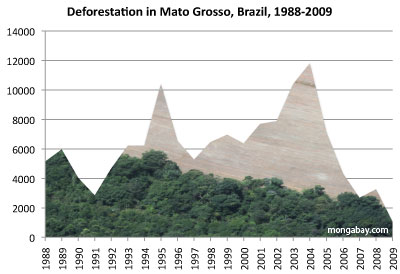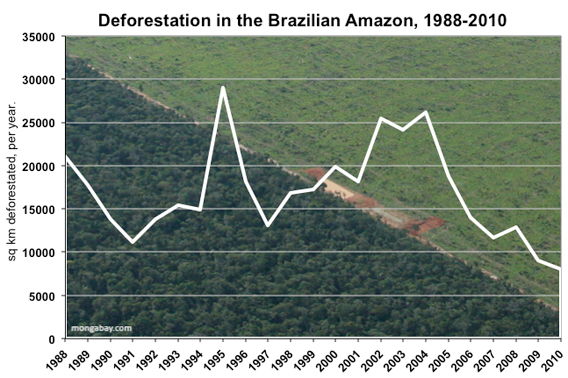By Rhett A. Butler, mongaby.com, May 18, 2011
New data from the Brazilian government seems to confirm environmentalists' fears that farmers and ranchers are clearing rainforest in anticipation of a weakening of the country's rules governing forest protection.
Wednesday, Brazil's National Space Research Agency (INPE) announced a sharp rise in deforestation in March and April relative to the same period last year. INPE's rapid deforestation detection system (DETER) recorded 593 square kilometers of forest clearing during the past two months, an area of rainforest 10 times the size of Manhattan and a 473 percent increase over the 103.5 sq km chopped down from March-April 2010.
 |
81 percent of the recent clearing occurred in Mato Grosso, the southernmost state in the Brazilian Amazon that has accounted for more than 35 percent of the region's deforestation since 1988.
"The recent deforestation in Amazonia detected by INPE has been concentrated in the agricultural areas of the Mato Grosso state," Gilberto Camara, Director of INPE, told mongabay.com. "Deforestation in these areas was high in the 1990s and early 2000s. From 2005 to 2010, due to increased law enforcement and private arrangements such as the Soy Moratorium, these areas had a substantial reduction on forest clearings."
INPE's announcement comes a day after Imazon, a research institute that also tracks deforestation, reported a big percent increase in clear-cutting. Imazon also found a surge in forest degradation, the logging, burning, and thinning of forest that often precedes deforestation.
The short-term deforestation tracking systems used by INPE and Imazon are used primarily for law enforcement. Both rely on relatively coarse satellite resolution, making them faster but less accurate than the systems used to determine annual deforestation, which is estimated every August. Month-to-month deforestation can be highly variable in Brazil, by clearing usually peaks in the dry season between July and October. High rates of clearing in April is unusual.

Until last month, the trend in the Brazilian Amazon had been very positive, with annual deforestation falling nearly 80 percent since 2004.
The increase in deforestation in April is thought to be linked to the current debate over Brazil's forest code, which requires land owners to maintain 80 percent of their holdings as forest in the Amazon region. Anticipating a weakening in the code that would grant amnesty for deforestation, farmers and ranchers have been clearing swathes of forest. Dry conditions, lingering from last year's worst-ever drought, have exacerbated the situation.
INPE's Camara told mongabay.com that IBAMA, Brazil's environment agency, just sent agents into the region to curb illegal clearing and report on what is causing the increase in deforestation.
Deforestation in the Brazilian Amazon is typically driven by industrial agriculture and land speculation. More than 70 percent of deforested land ends up as cattle pasture. High commodity prices typically create incentives for deforestation.
While only about 20 percent of the Brazilian Amazon has been lost to date, environmentalists fear that rising demand for food and fuel, combined with planned infrastructure projects and the effects of climate change, could doom much of the Amazon.

No comments:
Post a Comment